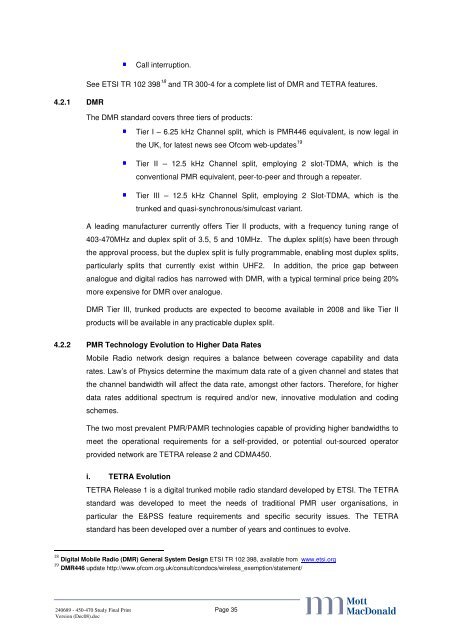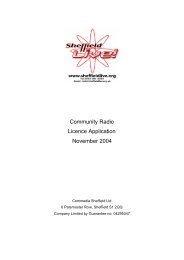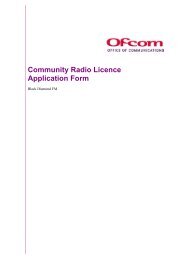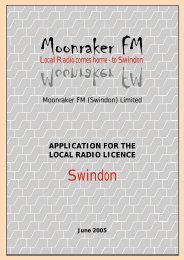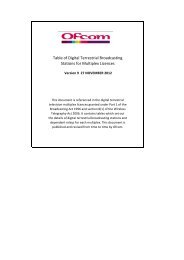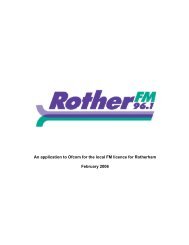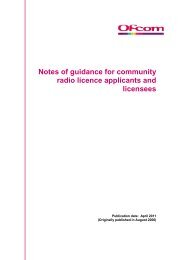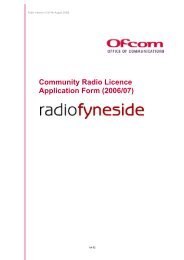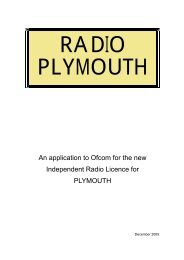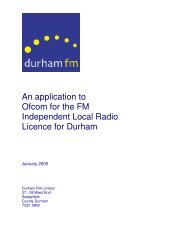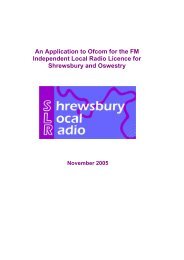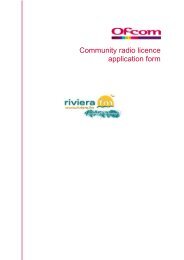UHF2 realignment study - Ofcom Licensing
UHF2 realignment study - Ofcom Licensing
UHF2 realignment study - Ofcom Licensing
Create successful ePaper yourself
Turn your PDF publications into a flip-book with our unique Google optimized e-Paper software.
4.2.1 DMR<br />
240689 - 450-470 Study Final Print<br />
Version (Dec08).doc<br />
Call interruption.<br />
See ETSI TR 102 398 18 and TR 300-4 for a complete list of DMR and TETRA features.<br />
The DMR standard covers three tiers of products:<br />
Tier I – 6.25 kHz Channel split, which is PMR446 equivalent, is now legal in<br />
the UK, for latest news see <strong>Ofcom</strong> web-updates 19<br />
Tier II – 12.5 kHz Channel split, employing 2 slot-TDMA, which is the<br />
conventional PMR equivalent, peer-to-peer and through a repeater.<br />
Tier III – 12.5 kHz Channel Split, employing 2 Slot-TDMA, which is the<br />
trunked and quasi-synchronous/simulcast variant.<br />
A leading manufacturer currently offers Tier II products, with a frequency tuning range of<br />
403-470MHz and duplex split of 3.5, 5 and 10MHz. The duplex split(s) have been through<br />
the approval process, but the duplex split is fully programmable, enabling most duplex splits,<br />
particularly splits that currently exist within <strong>UHF2</strong>. In addition, the price gap between<br />
analogue and digital radios has narrowed with DMR, with a typical terminal price being 20%<br />
more expensive for DMR over analogue.<br />
DMR Tier III, trunked products are expected to become available in 2008 and like Tier II<br />
products will be available in any practicable duplex split.<br />
4.2.2 PMR Technology Evolution to Higher Data Rates<br />
Mobile Radio network design requires a balance between coverage capability and data<br />
rates. Law’s of Physics determine the maximum data rate of a given channel and states that<br />
the channel bandwidth will affect the data rate, amongst other factors. Therefore, for higher<br />
data rates additional spectrum is required and/or new, innovative modulation and coding<br />
schemes.<br />
The two most prevalent PMR/PAMR technologies capable of providing higher bandwidths to<br />
meet the operational requirements for a self-provided, or potential out-sourced operator<br />
provided network are TETRA release 2 and CDMA450.<br />
i. TETRA Evolution<br />
TETRA Release 1 is a digital trunked mobile radio standard developed by ETSI. The TETRA<br />
standard was developed to meet the needs of traditional PMR user organisations, in<br />
particular the E&PSS feature requirements and specific security issues. The TETRA<br />
standard has been developed over a number of years and continues to evolve.<br />
18 Digital Mobile Radio (DMR) General System Design ETSI TR 102 398, available from www.etsi.org<br />
19 DMR446 update http://www.ofcom.org.uk/consult/condocs/wireless_exemption/statement/<br />
Page 35<br />
abc


